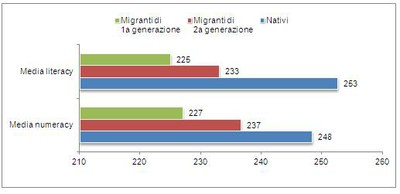PIAAC survey respondents belong to the major communities of foreign residents in Italy (Romanians, Moroccans, Albanians, Chinese, Ukrainians, etc.)[1], with a PIAAC sampling rate equal to 9.2% of the total survey sample. Given that these individuals are to be considered as “integrated immigrants”, with respect to this population segment a “positive self-selection” was applied by respondents themselves, an aspect to be taken into account when analysing data shown below [2].
Even though with different average scores, the Italian average of scores on the literacy and numeracy scales related to native respondents, to the so-called “recent” immigrants (who have been resident in the Country for less than five years) and to “permanent” immigrants (with five or more years of residence) follows a trend which is similar to other OECD Countries, and generally similar to the OECD average.
Even if the OECD average obtained by immigrants in the literacy tests ranks at level 2 (250 points), Italy falls within the group of Countries (along with Spain, Sweden and Korea) with a lower proficiency average (228 points).
However, the highest percentage of immigrants who participated in the PIAAC survey in our Country ranked at level 2 both for literacy and numeracy: immigrants’ average score in literacy tests is equal to 228 points, while their average numeracy score is 231 points.
The factor with the highest impact on skills for the immigrant population seems to be the number of years of stay in the host Country: those with ten or more years of residence in Italy obtained a significantly higher average score (232 points).
Gender differences show a better average proficiency in women (235 points) vs men (224 points), and second generation immigrants seem to have reached slightly higher results compared to first generation ones (225 points on the literacy scale, and 226 on the numeracy scale for the latter; on the other hand, 233 points on the literacy scale, and 236 on the numeracy scale are the average scores obtained by second generation immigrants).
From a demographic viewpoint immigrants’ skills are strongly related to their age when they migrated to the host Country: the best proficiencies were observed in individuals who migrated between 0 and 5 years of age, and got increasingly worse as immigrants’ age got older.
When considering the employment status of immigrants in our Country with respect to their skills, the percentage of full-time employed individuals appears to be higher among “permanent immigrants” compared to those who arrived in Italy five or less years ago, with a decreasing percentage of unemployed individuals. This data seems to be in line with proficiency results: as a matter of fact employed permanent immigrants tend to achieve higher average scores.
Average scores obtained by natives and 1st and 2nd generation immigrants on the Literacy and Numeracy scales

[1] According to data included in the 2012 Immigration Report by Caritas and Fondazione Migrantes these are the five most numerous foreign communities (EU and non EU in this order) in Italy.
[2] From a methodological point of view it’s worth noting that with regard to immigrants the sample was not so large as to be fully significant from a statistical perspective.
Overview and data processing by Ilaria Piperno.